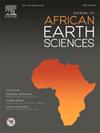阿尔及利亚Illizi盆地致密气储层的地质/岩石物理特征及渗透率填图
IF 2.2
4区 地球科学
Q2 GEOSCIENCES, MULTIDISCIPLINARY
引用次数: 0
摘要
储层渗透率和孔隙度的研究对于有效的油藏管理和制定生产策略至关重要。Illizi盆地是一个古生代-中生代板内凹陷,保留了超过7000米的沉积岩记录,包含世界级的石油系统,估计最终采收率(EUR)超过390亿桶油当量(BBOE)的碳氢化合物储量。然而,由于这些致密气藏复杂的地质环境和有限的井资料,预测和表征高渗透(K)层仍然具有挑战性。该研究解决了伊里兹盆地高渗透带准确识别和分类的关键难题。我们提出了一种新的方法,将传统的地质、沉积学和岩石物理分析与使用深度学习技术优化的先进人工神经网络(ann)相结合。该研究的重点是盆地的西北部,在那里使用常规方法区分渗透率相特别困难。这项工作的新颖之处在于应用了一种高效的人工神经网络模型来检测和分类高渗透层,大大提高了对储层内渗透率分布的理解。人工神经网络方法表现出优异的性能,能够准确分类渗透相,并在整个研究区域的所有井中检测高渗透层。这种将深度学习与传统储层表征技术的创新结合,为Illizi盆地等致密气藏的储层管理提供了更可靠的框架。本文章由计算机程序翻译,如有差异,请以英文原文为准。
Geological/petrophysical characterisation and permeability mapping using ANN in the Algerian tight gas reservoir, Illizi Basin
The study of reservoir permeability and porosity is paramount for effective reservoir management and formulation of a production strategy. The Illizi Basin is a Palaeozoic–Mesozoic intraplate depression that preserves over 7000 m of sedimentary rock record and contains world-class petroleum systems with an estimated ultimate recovery (EUR) of over 39 billion barrels of oil equivalent (BBOE) in hydrocarbon reserves. However, predicting and characterising high-permeability (K) zones in such tight gas reservoirs remains challenging due to their complex geological settings and limited well data. This research addresses the critical dilemma of accurately identifying and classifying high-permeability zones in the Illizi Basin. We propose a novel approach that combines conventional geological, sedimentological, and petrophysical analyses with advanced artificial neural networks (ANNs) optimised using deep learning techniques. The study focuses on the north-western part of the basin, where distinguishing permeability facies using conventional methods is particularly difficult. The novelty of this work lies in the application of a highly efficient ANN model for detecting and classifying high-permeability zones, significantly improving the understanding of permeability distribution within the reservoir. The ANN approach demonstrated exceptional performance, enabling the accurate classification of permeability facies and the detection of high-permeability zones in all wells across the study area. This innovative integration of deep learning with traditional reservoir characterisation techniques provides a more reliable framework for reservoir management in tight gas formations like in the Illizi Basin.
求助全文
通过发布文献求助,成功后即可免费获取论文全文。
去求助
来源期刊

Journal of African Earth Sciences
地学-地球科学综合
CiteScore
4.70
自引率
4.30%
发文量
240
审稿时长
12 months
期刊介绍:
The Journal of African Earth Sciences sees itself as the prime geological journal for all aspects of the Earth Sciences about the African plate. Papers dealing with peripheral areas are welcome if they demonstrate a tight link with Africa.
The Journal publishes high quality, peer-reviewed scientific papers. It is devoted primarily to research papers but short communications relating to new developments of broad interest, reviews and book reviews will also be considered. Papers must have international appeal and should present work of more regional than local significance and dealing with well identified and justified scientific questions. Specialised technical papers, analytical or exploration reports must be avoided. Papers on applied geology should preferably be linked to such core disciplines and must be addressed to a more general geoscientific audience.
 求助内容:
求助内容: 应助结果提醒方式:
应助结果提醒方式:


